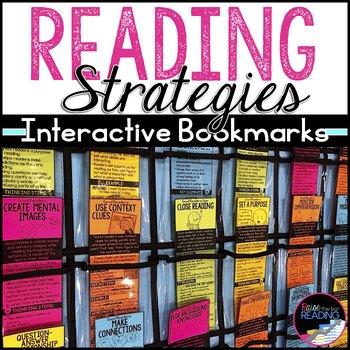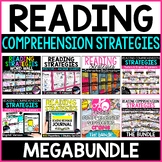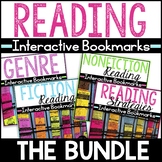Reading Strategies Bookmarks for Reading Response, Comprehension Activities
- PDF
What educators are saying
Also included in
- This megabundle contains EVERYTHING you could ever want in order to make teaching Reading Comprehension Strategies a breeze! From visuals (posters, word wall, bookmarks) to activities (reading passages, graphic organizers, digital activities, and hands on crafts), this megabundle has you covered!Price $97.00Original Price $210.25Save $113.25
- These interactive reading bookmarks are the perfect activity to reinforce using reading strategies (with any text), nonfiction skills, fiction skills, and understanding genre during independent reading. The front side of each reading bookmark has a student friendly definition of the skill with an alPrice $23.00Original Price $28.00Save $5.00
Description
These interactive reading bookmarks are the perfect activity to reinforce using reading strategies during independent reading!
The front side of each reading bookmark has a student friendly definition of the strategy with an aligning visual, details about how good readers use the strategy, and thinking stems to guide them in actively using the strategy during independent reading.
The back side of each has places for students to actively use the strategy while reading. Students can either 1.) place 2" by 2" sticky notes into the boxes on the back and then transfer their sticky notes to their Reading Strategies Note Tracker, or 2.) just use the back as a guide and write directly into the boxes on their Reading Strategies Note Tracker.
Please take a look at the product preview for a closer look at the bookmarks.
READING STRATEGIES INCLUDED:
- Use Background Knowledge
- Ask Questions
- Make Inferences
- Determine Importance
- Synthesize Information
- Create Mental Images
- Monitor Comprehension
- Use Reading Strategies (all above)
- Question-Answer Relationship (QAR)
- Make Connections
- Text to Self Connections
- Text to Text Connections
- Text to World Connections
- Create Sensory Images
- Set a Purpose
- Make Predictions
- Draw Conclusions
- Use Context Clues
- Close Reading
- Use Spelling Strategies
- Read Fluently
2 PRINTING OPTIONS INCLUDED:
1.) Print Double-Sided (4/page): Directions are included for how you can print double sided from the PDF. You can of course make a master one-sided copy of both the front and back of each and create your own double-sided bookmarks using a copy machine if you would rather go that route.
2.) Print One Side Only (2/page): The front and back of two book marks can be printed on one side. Simply cut down the middle, fold the front to the back and glue them together. You could also leave it open (rather than gluing the front to the back) and that side for students to mark vocabulary from the text, a spelling pattern they are working on, etc.
Looking for more ways to teach reading strategies? Check out these resources below!
- Reading Strategies Posters (contains the same information as bookmarks)
- Reading Strategies Word Wall
- Reading Strategies Graphic Organizers







